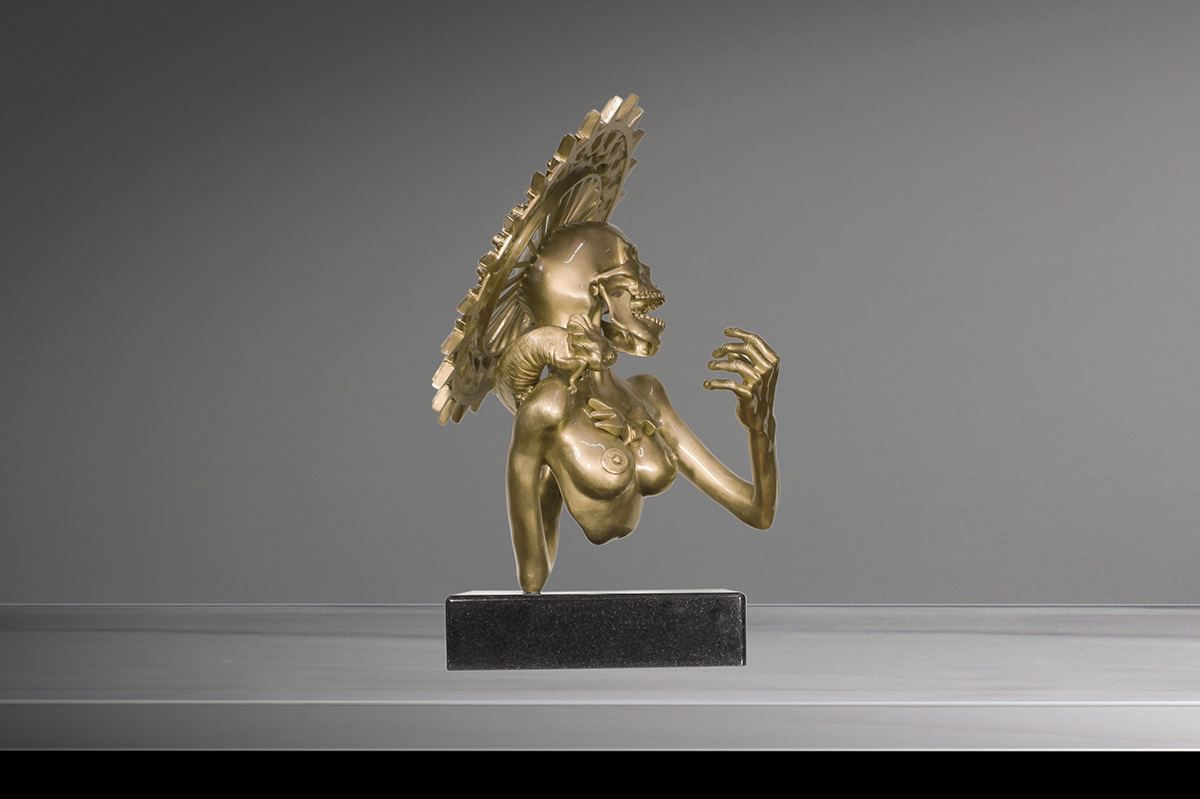
COYOLXAUHQUI
2 de December de 2022
The Mexican Skulls from the hands of Perla Arroyo had to be beautiful, it is part of her nature to create harmonious and aesthetically pleasing objects. But beauty can also be terrible and, in this sense, his works strip away the syrupy varnish of the stereotype that has shaped them in recent years. They are not skulls with pretty makeup, their empty sockets remind us of the reality of death, and their teeth reflect the rawness of death that is Mexico’s daily bread. Arroyo does not fall into the classic feminine discourses and creates fresh voices for those skulls, while rescuing and recreating stories that we already know from a new perspective and, at the same time, reconquering the colonizing image of the memento mori (the human skull) by means of Mexican symbolic elements.
In the case of the Coyolxauhqui, it resorts to the syncretism that characterizes Mexican religions and arts. Its crown is reminiscent of the halo of the Virgin of Pilar. Auras are not exclusive to the Catholic religion and can be related to spiritual strength, in this case, the halo formed of spears? knives? represents the warrior strength of Coyolxauhqui, in addition to having the Mexica year 0 (zero) inscribed on it, the date of birth of his brother Huitzilopochtli, which can even be considered a bad omen in the Mexica ideology, since being born to kill was contrary to the duality and equity of the dichotomous forces that lived in harmony in nature, before the bloody Aztec imperialist model was imposed. This skull is topped with strong, almost masculine hands, capable of lifting a son or an obsidian mallet alike.
The full and intact breasts reveal her incarnation process. Like Coyolxauhqui in pre-Hispanic representations, she shows no sign of having lost her heart in a sacrifice. On her shoulder she carries an ajolote, an animal loaded with symbolism and whose enigmatic face inspired Cortázar to dedicate a short story to it. Another curious fact about salamanders is that they have the ability to regenerate “bones, muscles and nerves in the right places”, they are even capable of regenerating their spinal cord. ¹
In Aztec mythology, Coyolxauhqui was sacrificed by Huitzilopochtli, who decapitated, dismembered and scattered her limbs.
Thus, Arroyo’s Coyolxauhqui can also be interpreted as an image of renewal, of self-reconstruction. Writer Gloria Anzaldúa calls the writing process “putting Coyolxauhqui back together again”², putting together the bones, flesh and ligaments that make up a story to give it a coherent final form. By extension, Anzaldúa calls the different processes of psychic, cultural and emotional reconstruction the “Coyolxauhqui imperative”.
On the chest is a butterfly, which in Greece (and Japan) symbolizes the soul, and even the word for soul and butterfly is the same in Greek: psyché. In still lifes of the vanitas type caterpillar, chrysalis and butterfly represent life, death and resurrection³. The butterfly is also a representation of Oyá or Iansã in African and Afro-Brazilian religions, which, besides believing in reincarnation, also consider life as a sequence of cycles, and each time a cycle concludes, spiritual growth is achieved. This process is called Balé de Iansã.
According to archaeological investigations of pre-Hispanic history, Coyolxauhqui was punished for confronting the masculine power of Huitzilopochtli, and even reinforces the image of the masculine that forcibly overrides the feminine that resorts to black magic or other mysterious arts to achieve its objectives.4 In contrast to that well-known image of the shattered and defeated Coyolxauhqui, forged by Spanish Christian morality without mercy or depth, given that the sacrifice of a warrior like her represented a great honor to the strength of the feminine, Arroyo brings us the image of a recovered and renewed spiritual force. A victory out of defeat that anyone who has suffered an emotional fall and come out of it can relate to, regardless of gender or age. Therefore, I cannot end this text without thanking Perla for the richness, knowledge and depth that she gives to the Mexican skulls and that feed mind and spirit, since with her work, she refers to the philosophies that consider death as an intimate part of the cycle of life, one cannot exist without the other, and gives us a sharp reflection on death so that we can make a sharp reflection on life.
1
See https://www.bbc.com/mundo/noticias-42918181
2
Anzaldúa, Gloria. Light in the dark = Luz en lo oscuro: rewriting identity, spirituality, reality. Duke University Press: Durham, North Carolina, USA. 2015. P. 107.
3
Hall, James. Illustrated Dictionary of Symbols in Eastern and Western Art. West View Press, Colorado. 1994. P. 14.
4
Klein, Cecilia. Fighting with Feminity: Gender and War in Aztec Mexico. Studies in Nahuatl Culture. No. 24. 1994. P. 225.
Francisco Rocha, Sao Paulo 09 September 2022
BOLETÍN
* Llenado obligatorio para continuar
Al suscribir aceptas los términos, políticas y condiciones de este sitio web.
Podrás cancelar tu suscripción a través del correo que recibas de nuestra parte en el momento que desees.
